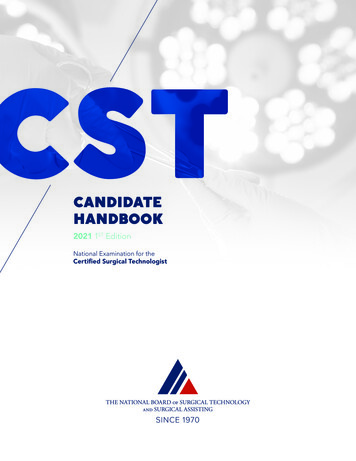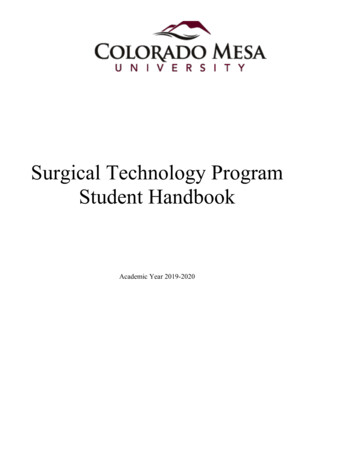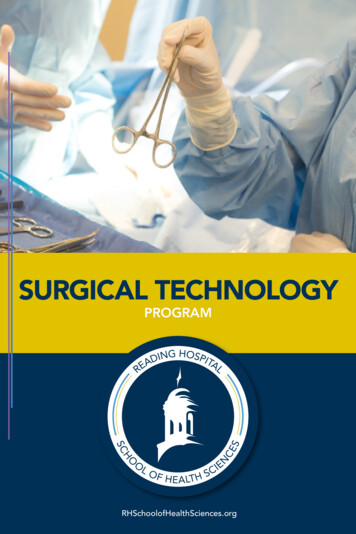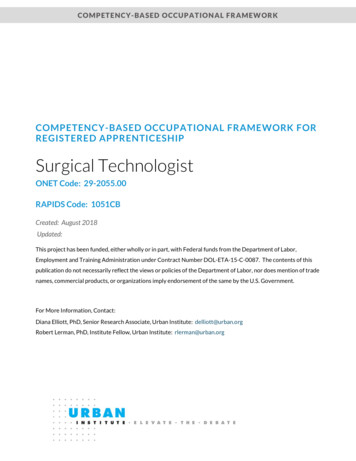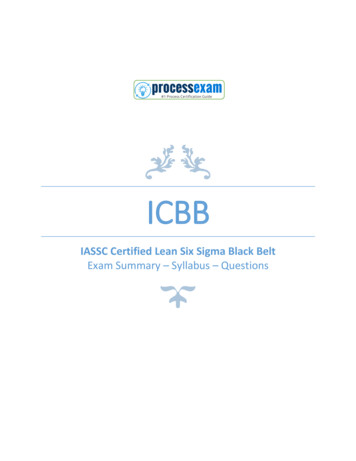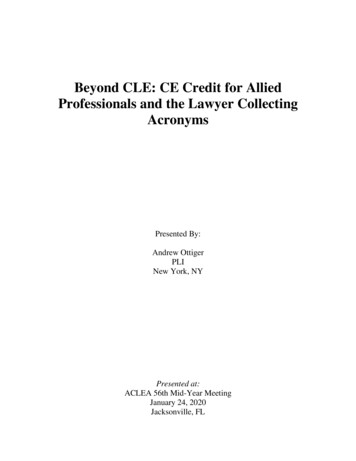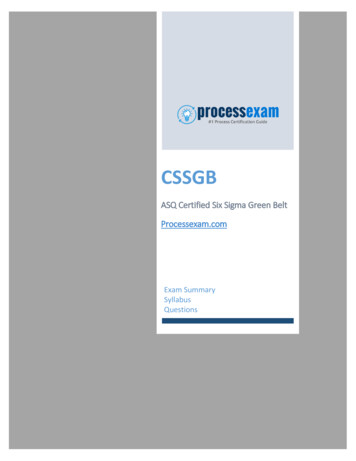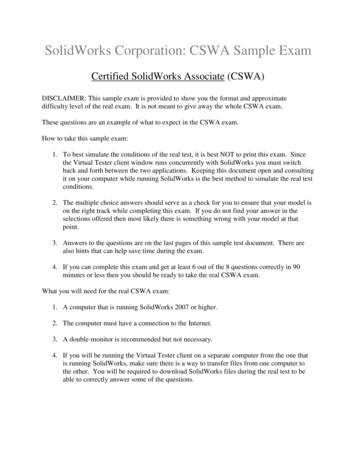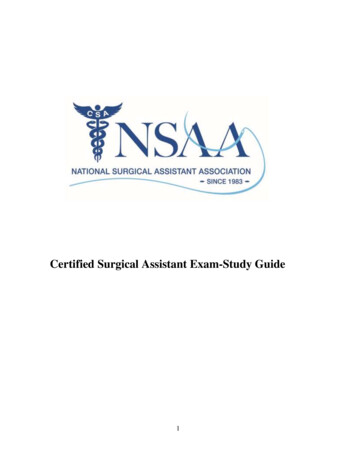
Transcription
Certified Surgical Assistant Exam-Study Guide1
INTRODUCTIONThe CSA exam is developed by the National Commission for the Certification ofSurgical Assistants (NCCSA), with support by the National Surgical AssistantAssociation (NSAA), and provides qualified surgical assistant candidates theopportunity to achieve “standards-based” national certification.The 150 question Certified Surgical Assistant exam has been meticulouslydeveloped by Certified Surgical Assistant Subject Matter Experts under the guidancea leading psychometry firm specializing the development of examinations toaccurately measure knowledge, skills and attributes (KSAs) of surgical assistantgraduates, or other qualified professionals challenging the CSA examination.Successfully passing the CSA examination requires a general knowledge ofmedicine and with a solid command surgical procedure knowledge in all surgicalsubspecialties, surgical anatomy, human physiology, surgical technique, medicalterminology, and surgical instrumentation commonly used in surgery. The contentand questions of the CSA exam have been verified by surgeons, and reflect afundamental knowledge base competency for an entry-level surgical assistant.Educators from current surgical assistant programs have input into the breadth ofsubject matter covered in the CSA exam, but have no knowledge of the specificquestions, nor participate in creating the exam, specific exam questions, or the CSAExam Study Guide.THE STUDY GUIDEThis study guide does not contain all the material a surgical assistant must commandin his or her practice, nor does it cover the entire scope of didactic lectures in asurgical assistant training program.The Table of Contents are not specifically indicative of sections on the actualexamination, but provide a basic framework for study. Additional references arelisted with which, a candidate choose for deeper subject matter review.SAMPLE QUESTIONSAnswers to the sample questions found in each section are located in Appendix IV,at the end of this study guide.2
TABLE OF CONTENTS1. MEDICAL TERMINOLOGY2. PHYSIOLOGY and ORGAN SYSTEMS3. SURGICAL ANATOMY4. SURGICAL PROCEDURES5. SURGICAL TECHNIQUES6. APPENDIXI. Greek/Latin PrefixesII. Supplemental Study MaterialIII. Additional references for ReviewIV. Answers to Sample Questions3
PART 1: MEDICAL TERMINOLOGYUnderstanding medical and surgical terminology is an essential component of communicationin the OR, and to the understanding of medicine. Working in the OR setting for significantextended periods of time exposes medical professionals to terminology as it is used in patientcare. Further study of medical terminology, however, is crucial to understanding medicine, andrepresents a large part of surgical assistant training curriculum.A. ANATOMIC ORIENTATION:Anatomic “orientation” terminology may be found in anatomy textbooks such as Gray’sAnatomy, Alexander’s Care of the Patient in Surgery, by Rothrock, and many others.Successful completion of surgical procedures requires the surgeon and the assistant toaccurately and efficiently navigate the steps in the proper sequence, and often in unison.Anatomic orientation terminology provides a key “language” for this communication.Image source: tomic-terms-of/, accessed 10/1/17, 11:00pm4
Anatomic “Orientation” Vocabulary examples include: Anterior: The front, as opposed to the posterior. Anteroposterior: From front to back, as opposed to posteroanterior. Caudad: Toward the feet (or tail in embryology), as opposed to cranial. Caudal: Pertaining to, situated in, or toward the tail or the hind part. Or below anotherstructure. Cranial: Toward the head, as opposed to caudad. Deep: Away from the exterior surface or further into the body, as opposed to superficial. Distal: Further from the beginning, as opposed to proximal. Dorsal: The back, as opposed to ventral. Horizontal: Parallel to the floor, a plane passing through the standing body parallel tothe floor. Inferior: Below, as opposed to superior. Inferolateral: Below and to one side. Both inferior and lateral. Lateral: Toward the left or right side of the body, as opposed to medial. Medial: In the middle or inside, as opposed to lateral. Posterior: The back or behind, as opposed to the anterior. Posteroanterior: From back to front, as opposed to anteroposterior. Pronation: Rotation of the forearm and hand so that the palm is down (and thecorresponding movement of the foot and leg with the sole down), as opposed tosupination. Prone: With the front or ventral surface downward (lying face down), as opposed tosupine.5
Proximal: Toward the beginning, as opposed to distal. Sagittal: A vertical plane passing through the standing body from front to back. The midsagittal, or median plane, splits the body into left and right halves. Superficial: On the surface or shallow, as opposed to deep. Superior: Above, as opposed to inferior. Supination: Rotation of the forearm and hand so that the palm is upward (and thecorresponding movement of the foot and leg), as opposed to pronation. Supine: With the back or dorsal surface downward (lying face up), as opposed to prone. Transverse: A horizontal plane passing through the standing body parallel to the ground. Ventral: Pertaining to the abdomen, as opposed to dorsal. Vertical: Upright, as opposed to horizontal.Source: iclekey 9210, accessed 10/1/17, 10:20pm.SAMPLE QUESTION 1.3: The surgeon asks you to first gently supinate, then gentlypronate the operative wrist of a 14-year old patient in supine position. The operativeextremity is positioned at 80 degrees to the torso. Which of the following most accuratelydescribes the movement of the operative thumb (which direction it points) as you carryout the instructions?o Thumb lateral, then back to medial.o Thumb medial, then back to lateral.o Thumb superior, then back inferioro Thumb inferior, then back to superiorSAMPLE QUESTION 1.2: With patient in the prone position, the dorsal roots of thespinal nerves are oriented:o Deep to its corresponding ventral rootso Superficial to its corresponding ventral rootso Cranial to its corresponding ventral rootso Caudal to its corresponding medial roots.To research the following questions 1.3 through 1.5, please refer to Latin and Greek Roots ofMedical Terminology in Appendix I.6
SAMPLE QUESTION 1.3: A choledoco-duodenostomy refers to the surgical anastomosisof which of the following two structures:o Gall bladder with the common bile ducto Common bile duct and fundus of the stomacho Duodenum and common bile ducto Pancreatic duct and antrum of the stomachSAMPLE QUESTION 1.4: In knee arthroscopy, the antero-medial portal is placed:o on the same side of the patella as the Ilio-tibial band.o on the opposite side of the patella from the pes anserinus.o superior to the quadriceps insertion on the patella.o proximal and anterior to the pes anserinus, medial to the patellar ligament.SAMPLE QUESTION 1.5: Epidural anesthesia is administered:o Anterior (deep to) to the lumbar or sacral nerve roots.o Into the space between the spinal canal and the dura mater covering the nerve roots.o Into precisely the same subarachnoid space as spinal anesthesia, but in the sacral area.o Directly into the cerebral spinal fluid at any point from the ventricles in the brain, to thecauda equina.Consider consulting the following sources for in depth study. Atlas of Human Anatomy, Frank H. Netter, MD, 6th Edition, Elsevier NorthHolland, Inc., New York, NY. Gray's Anatomy, The Anatomical Basis of Clinical Practice, 41st Edition, SusanStandring, Elsevier North Holland, Inc., New York, NY. Human Anatomy, R.M.H McMinn, R.T. Hutchings, second edition, Year BookMedical Publishers, Chicago, IL, 1988. Human Anatomy, A Synoptic Approach, Nicholas James Mizeres, Elsevier NorthHolland, Inc., New York, NY, 1981. Essentials of Surgery, James M Becker, MD, and Arthur F. Stucchi, PhD,Saunders, Philadelphia, PA, 2006. Textbook of Medical Physiology, 8th Edition, Arthur C Guyton, M.D., W.BSaunders Company, Philadelphia, PA. 1991.7
PART II: ORGAN SYSTEMS and PHYSIOLOGYA. The Musculoskeletal system:a. Muscle Physiology:B. The Vascular System:C. The Cardio-Pulmonary System:D. The Nervous System:E. The Digestive System:F. The Endocrine System:G. The Excretory System:H. The Lymphatic System:The arrangement of anatomic structures in the body support the physiologic function ofthe organ systems. These organ systems include the: musculoskeletal; cardio-pulmonary;circulatory; nervous; digestive; endocrine; excretory; reproductive; sensory;integumentary; and immune systems.Surgical procedures in one region impact all the body systems to a greater or lesserdegree. For this reason, the surgical assistant is well-served to carry a fundamentalunderstanding of the physiology within each organ system, its anatomic locations/s in thebody, and be ever vigilant to correctly identify organ system structures.Avoiding or minimizing traumatic impact to structures peripheral to the procedure athand, minimizes unnecessary mortality and morbidity of the case.8
A. The Musculoskeletal system:Skeletal anatomy must be committed to memory, including the skull, spine, and distalextremities. Tubercles, tuberosities, fossae, canals, and fissures represent importantfeatures relative to connective tissue attachment, vascular supply, bone growth, and bonemarrow function.Joint alignment, articular cartilage, and soft tissue support; as well as muscular insertions,origins, and innervations; and principle including agonist/antagonist pairing should bestudied. Such understanding underpins the importance for the identification andpreservation of normal anatomy during surgery.SAMPLE QUESTION 2.1: The connective tissue between the patella and the tibialtuberosity in the knee facilitates quadriceps muscle contraction across the kneejoint. What is this structure?o Patellar Ligamento Quadriceps Tendono Vastis Lateraliso Vastis MedialisSAMPLE QUESTION 2.2: The talus forms an articulation with which of thefollowing lists of bones:o Navicular, cuneiform, fibula and calcaneuso Tibia, cuboid, fibula, and cuneiformo Calcaneus, navicular, tibia, and calcaneuso Fibula, cuneiform, calcaneus, and tibia9
SAMPLE QUESTION 2.3: The acetabulum, or hip socket, is comprised of thefusion of which of the three bone choices below?o Ilium, sacrum, and pubis.o Pubis, sacrum, and ischium.o Pubis, ischium, and ilium.o Sacrum, ischium, and ilium.Image source; http://muscle.ucsd.edu/MusIntro/ecc.shtml, accessed 11/28//17a. Muscle Physiology:Muscle tissues throughout the body, including striated, smooth, and cardiac muscle typesoperate via myofibril motor units activated by nerve impulse and neurotransmitter action.Acetylcholine release and reuptake represents one key biochemical step in musclemetabolism and may be acted on by anesthetic agents used in the operating room.Another point of pharmaceutical intervention comes from the calcium ion and potassiumion exchange following contraction.Errant electrical stimulation may affect contractility of muscle tissue. Lactic acid buildup in muscles becomes a potential issue for patients who have not been moved duringvery long procedures. Sudden position change can have systematic effects.SAMPLE QUESTION 2.4: A large bolus of potassium given intravenously to apatient may have catastrophic effects on cardiac muscle and ultimately arrestcardiac function. The mechanism for this problem is described in which of thefollowing statements: Potassium in the intracellular space blocks repolarization of the muscle cellmembrane Calcium and potassium inside the cell reach toxic levels Potassium displaces calcium across the nuclear membrane Calcium displaces sodium across the nuclear membrane10
B. The Vascular System:Image Source: wer-torso/blood-supply-stomach-pancreas, accessed 11/26/17During surgery, blood flow must be protected from disruption. A working knowledge ofthe blood supply to all organs, extremities, and tissues remains paramount to surgicalsuccess. Arteries, arterioles, capillaries, venules, and veins all have distinct properties andrequire specific handling. A working knowledge of this anatomy, as well as vasculartissue handling techniques, optimizes surgical success.Image Source: , accessed 12/22/1711
Temporary blood flow restriction with cross clamping or the use of a tourniquet, or avariety of intraoperative bypass procedures carry their own sets of procedural caveats.Deliberate and permanent hemostasis for resection procedures also require preciseplanning and excellent technique.Image source: https://en.wikipedia.org/wiki/Tunica media#/media/File:Illu artery.jpg, accessed 12/2/17Turbulence in the vasculature occurs with vascular injury or blockage. One measure ofthis phenomenon is “shear rate”, defined as the local velocity gradient between adjacentblood flow. Shear rate, incidentally, has also been shown to be one of the main regulatorsof platelet activation and thrombosis. This basic understanding underpins the necessityfor resecting aneurismal tissue with meticulous care.SAMPLE QUESTION 2.5: The superior mesenteric artery provides primary bloodsupply for which of the following structures:o Esophaguso Pancreaso Stomacho Spleen12
SAMPLE QUESTION 2.6: The uterine artery is a most commonly a direct branchof the:o Internal iliac arteryo External iliac arteryo Common iliac arteryo Gonadal arteryC. The Cardio-Pulmonary System:Cellular function throughout the tissues and organs of the body rely on the delivery ofoxygen and nutrients, and facilitation of cellular waste removal. Immune and endocrinefunction depend on adequate circulation. Osmotic forces maintained at the cellular level,and physiologic safeguards such as vasodilation and vasoconstriction, preserve theintegrity of the closed circulatory loop.13
Image source: https://en.wikipedia.org/wiki/Vagus nerve#/media/File:Gray503.png, accessed 12/3/17The surgical assistant must thoroughly understand the anatomic features of the thoraciccavity, including cardiovascular and pulmonary anatomy, including its innervation. Heor she must also be fully aware of the challenge surgical procedures pose to a patient’snormal hemodynamic status. Patient blood volume, blood pressure, oxygen saturation,and cardiac function must be protected. Additional parameters such as tourniquet time,patient positioning, clotting status, and autonomic nerve (vagal) responses should also bewell understood, since they affect patients’ immediate response to surgery.Normal lab values should be part of a surgical assistant’s working knowledge base, suchas O2 saturation, clotting time, hemoglobin, hematocrit, etc.SAMPLE QUESTION 2.7: After what percent of total blood volume may arterialpressure AND cardiac output begin to significantly (and precipitously) drop?o More than about 5%o More than about 10%o More than about 20%o More than about 25%SAMPLE QUESTION 2.8: Putting a patient into Trendelenberg position has theeffect of:o Decreasing blood flow to the braino Decreasing blood flow to the coronary arterieso Increasing blood flow to the braino Increasing blood flow to the coronary arteries14
SAMPLE QUESTION 2.9: A history of crushing wound to the chest, a patientexhibits the following symptoms: low blood pressure; chest pain radiating to theneck, shoulders, and back; trouble taking deep breaths and rapid shallowbreathing. Which of the following cardio-pulmonary conditions may responsibleand require urgent surgery?o Pericarditiso Cardiac Asynchronyo Cardiac Tamponadeo Pericardial EffusionSAMPLE QUESTION 2.10: Which of the following may be a cause of acutecyanosis in a patient undergoing a surgical procedure:o Lower than normal hemoglobino Higher than normal hemoglobino Lower than normal hematocrito Higher than normal hematocritD. The Nervous System:Image source: https://farm8.staticflickr.com/7392/27081043110 9aea88f11e b.jpg, accessed 12/2/17The complex, delicate structures that make up the nervous system — the brain, spinalcord and peripheral nerves — are susceptible to various types of injury ranging fromgross trauma and neurodegenerative diseases, to localized iatrogenic injury duringtreatment.15
Neuroanatomy must be learned from a systematic perspective, that is, with emphasis onthe somatic and autonomic function of the brain and central nervous system. For thesurgical assistant, however, an in-depth knowledge of neuroanatomy from a procedurespecific regional approach is also paramount.Careful study of the cranial nerves and their function provides a surgical assistant theability for high-level communication with the surgeon on the potential complications ofmisidentification of structures especially in head and neck procedures.Image source: https://farm4.staticflickr.com/3922/14577738497 b4c1614477 b.jpg, accessed 12/2/17In spinal surgery, the anatomy of the spinal cord and meningeal layers stand cruciallyrelevant. The spinal nerves, their dorsal and ventral roots, and their exit points along thespinal canal must be protected. The bony anatomy of the spinal column itself should bestudied.Image source: https://farm4.staticflickr.com/3922/14577738497 b4c1614477 b.jpg, accessed 12/2/1716
In the periphery, location of nerve fibers relative to the organs and structures theyinnervate, as well as their relation to adjacent anatomical landmarks, takes the highestpriority in most procedures. On the front end of many surgical procedures, identificationof these nerve structures must be accomplished with certainty.SAMPLE QUESTION 2.11: Direct inadvertent stimulation of the Vagus nerveduring carotid endarterectomy may have which of the following transient affects: Bradycardia Tachycardia Alkalosis AcidosisSAMPLE QUESTION 2.12: A “foot drop” results from insufficiency of the extensormuscles in the foot, and may be caused by lumbar disc herniation (damage to anerve root in the lumbar spine), or damage to/compression of the nerve asit courses superficial to the fibular head. peroneal pudendal posterior tibial suralSAMPLE QUESTION 2.13: The recurrent laryngeal nerve is a branch of the: Phrenic Nerve Facial Nerve Brachial Plexus Vagus Nerve17
E. The Digestive System:Image source: -management/expect/digestive diagram/, accessed 12/21/17Surgery of the digestive system represents a very large segment of general surgicalprocedures and is thus very important to the surgical assistant. From the esophagus,through the diaphragm, and at numerous points along the alimentary canal, commonlyperformed surgical procedures address acute and chronic G.I. disease.With the ever-expanding field of minimally invasive G.I. surgery, surgical assistants mustbe expert at open procedures, as well as laparoscopic/endoscopic cases. Access to eacharea of the abdomen, therefore, must be carefully planned and executed.18
Image Source: 0031/4-6286, accessed 12/21/17An understanding of blood supply, anatomic relationships, along with tissue-handling andanastomosis techniques represent crucial knowledge areas. Identification of G.I. tractpathology, infarction, perforation due to disease are important. Constant proactiveprevention of intra-operative injury and post-operative surgical adhesions represent askillset retained by the competent surgical professional.An in-depth study of microscopic anatomy and physiology of the digestive system shouldalso be undertaken. This fundamental understanding underpins the necessity foradherence to proper technique. Furthermore, crucial production of digestive enzymes,hormones and chemical messengers are carried out in the pancreas, liver, and cells withinthe epithelial layers of the G.I tract itself and must be maintained to facilitate normaldigestion of nutrients.19
Image source: histology-alimentary-canal/, accessed 12/21/17Image Source: e/biology/faculty/harnden/2122/notes/digest.htm, accessed 12/21/17Perforation of the digestive system carries dire consequences for patients, and presents asurgical emergency.Image source: https://www.learningmedical.co/archives/1403, accessed 12/22/17SAMPLE QUESTION 2.14: The anatomic region bordered by the cystic duct, thecommon hepatic duct, and the cystic artery is referred to as: Tetralogy of Fallot Calot's triangle Circle of Willis Anatomical snuffboxSAMPLE QUESTION 2.15: The inferior mesenteric artery serves as principalblood supply to which of the following structures: The Ileocecal Valve The Caecum The Hepatic Flexure of the colon The Splenic Flexure of the colon20
SAMPLE QUESTION 2.16: The short gastric arteries are direct branches of whichof the following: Splenic Artery Left Gastric Artery Right Gastric Artery Right Gastroepiploic ArteryF. The Endocrine System:Image 1 source: m, accessed 12/22/17Image2 source: ohypophysis.html, accessed 12/22/17The endocrine system works alongside of the nervous system to form the hormonalcontrol systems of the body. Hormones are distributed by glands through thebloodstream and carry widespread, long-lasting, and powerful effects on cells of organsand tissues throughout the body.Many hormones produced by the endocrine system are classified as tropic hormones. Atropic hormone, such as those produced by the pituitary gland, such as TSH, ACTH, andFSH, function as triggers for the release of another hormone in another gland,A large percentage of surgery directly involving the endocrine system include procedureson the thyroid and parathyroid glands, the adrenal glands, the pancreas, the reproductiveorgans, and the pituitary gland. Careful study of the anatomy, function, control, andhormones produced by these glands must be undertaken.Surgery on these areas, furthermore, carry significant risk to vital structures adjacent tothe glands themselves, thus intraoperative identification of structures is key. Minimally21
invasive approaches often improve outcomes, but also add complexity to theseprocedures.SAMPLE QUESTION 2.17: Which of the flowing statements are true regardingtotal thyroidectomy procedures?o Potential post-op complications are relatively minoro The presence of hyperparathyroidism should be carefully monitoredpostoperativelyo The open approach generally utilizes a low transverse collar incisiono Most complications are immediately apparent through intra-operativediagnostic testingSAMPLE QUESTION 2.18: During total nephrectomy and/or adrenalectomy,which of the following poses the greatest intra-operative risk from a systemicperspective, during the manipulation of the adrenal gland?o Rapidly dropping blood glucose levels.o Rapidly elevating blood glucose levels.o Rapid blood pressure change.o Disseminated intravascular coagulopathy (DIC).SAMPLE QUESTION 2.19: Which of the following are true statements regardingthe pancreas?o The pancreas is a mixed exocrine and endocrine organ.o The pancreas lies in direct relation to the portal vasculature, the biliary tree, thevena cava, the celiac ganglia, and the spleen its vasculature.o Endocrine and exocrine function are distributed throughout the head, neck,body, and tail sections.o All of the above are true statements.22
G.The Reproductive System:Image source: 83, accessed 12/22/17Reproductive surgery represents a very large proportion of surgical proceduresperformed, and surgical assistants must be thoroughly educated in reproductive anatomy,function, and pathology. By default, gross anatomy of the pelvis becomes critical,including skeletal structures and landmarks, innervation and vascular supply, and theextremely relevant pelvic floor.Image Source: https://www.learningmedical.co/medical/anatomy, accessed 12/22/17Structures and external landmarks of the lower abdominal wall play key roles in thesurgical approach to the pelvis. Pelvic systems and structures must be studied by thecompetent surgical assistant, especially with regard to female reproductive procedures.23
SAMPLE QUESTION 2.20: The fold of peritoneum that connects the sides of theuterus to the walls and floor of the pelvis is known as the:o Pelvic ligament.o Round ligament.o Broad ligament.o Poupart's ligament.SAMPLE QUESTION 2.21: Innervation to the external genitalia are supplied bythe:o Inferior hypogastric plexuso Pudendal nerve and its brancheso Pelvic splanchnic nerveso Inferior gluteal nerve and its branchesH.The Excretory System:Image source: s-of-excretory-system/#s, accessed12/22/17The excretory system performs the function of eliminating wastes produced inmaintaining homeostasis. There are organ systems of the body that are involved in thisprocess such as sweat glands, lungs, and the kidneys. The liver plays an important role aswell, in detoxifying metabolites for excretion elsewhere.Sweat glands actively excrete lactic acid, urea, as well as various salts, pulling waterfrom the tissues. This process produces several critical affects. Alveolar structure within24
the lungs facilitate carbon dioxide and other toxic gases release from hemoglobin, as wellas the uptake of oxygen.One of the most important functions of the kidney is the filtration and excretion ofnitrogenous waste products from the blood. The measurements of elevated blood ureanitrogen (BUN) and creatinine serve as indicators of decreased renal function indicativeof the decreased clearance of these waste products.Through a complex physiologic process, the kidney nephron also maintains blood pH,regulates water content in blood, and therefore further affects systemic blood volume andblood pressure. The urinary system carries the waste products and fluids (urine) from thebody.Thorough knowledge of kidney anatomy, the urinary system, and normal blood chemistryand osmotic forces involved in excretion are necessary for complete understanding of thiscomplex process.SAMPLE QUESTION 2.22: The passage of urine from the kidney into the urinarybladder follows which of the following pathways:o Renal calyx, collecting tubules, renal pelvis, Bowman’s capsule, and urethra.o Collecting ducts, renal pelvis, urethra, Bowman’s capsule, and ureterso Bowman’s capsule, collecting ducts, renal calyx, renal pelvis, and uretero Collecting ducts, renal pelvis, renal calyx, Bowman’s capsule, and ureterSAMPLE QUESTION 2.23: Following anesthesia, the speed of emergence isdirectly related to alveolar ventilation (an excretory function of the lung) andinversely related to blood gas solubility. Which of the following statements is alsolikely true?o Hypoventilation lengthens the time taken to exhale the anesthetic agent anddelays recovery.o Hyperventilation lengthens the time taken to exhale the anesthetic agent anddelays recovery.o Hypoventilation shortens the time taken to exhale the anesthetic agent anddelays recovery.o Hypoventilation lengthens the time taken to exhale the anesthetic agent andspeeds up recovery.SAMPLE QUESTION 2.24: All but which one of the following may cause acutekidney failure:o Hypovolemia due to hemorrhageo Obstruction of urinary flowo Suprarenal cross-clamping of the aortao Optimized cardiac output25
I. The Lymphatic System:Image Source: ymphatic-system.html, accessed 12/22/17Lymph is the extracellular fluid in which cells bathe. An adult body contains around 10liters of lymph, consisting of salts, sugars, amino acids, hormones, coenzymes,neurotransmitters, fatty acids and the metabolic waste products. The lymphatic has nocentral pump nor fixed vascular enclosure, per se. Movement of lymph occur throughperistalsis, and muscular action of surrounding tissues.Blood components do not come in direct contact with the tissue cells, but must exit theblood vessels and pass into the interstitial lymphatic fluid. The lymph then carries outcellular exchanges, and subsequently carry materials which do not re-enter the bloodstream through the lymphatic vessels, through plexi and lymph nodes before entering thelarge lymphatics trunks for ultimate collection and drainage to the subclavian vein. Thelymph nodes, spleen, and thymus gland comprise integral parts of this system.26
Image source: -nodes/, accessed 12/22/17 Lymph nodes produce lymphocytes, and screens the lymph and engulfs theharmful pathogens, poisons, and abnormal (cancerous) cells. The spleen is a chief site for immune cell formation, acts as a reservoir for blood,and functions in the destruction of old blood (red and white) cells. The thymus gland harbors and produces lymphatic cells, thus influences the entireimmune system.SAMPLE QUESTION 2.25: A lymph node dissection near a cancerous tumor mayconfirms may the presence of cancer cells. Removal of the entire downstream chainof lymph nodes may be performed to eliminate further lymphatic spread. Which ofthe following statement most accurately describes a “Sentinel” lymph node biopsy?o Removal and biopsy of successive lymph nodes starting at the known tumor sitealong the lymphatic pathway until all nodes in a region are resected.o Needle biopsy of all regional nodes and removal of only the “affected” ones.o Biopsy and removal of the single most affected node.o Removal and biopsy of successive lymph nodes starting at the known tumor sitealong the lymphatic pathway until a “negative” node is discovered.Consider consulting the followin
subspecialties, surgical anatomy, human physiology, surgical technique, medical terminology, and surgical instrumentation commonly used in surgery. The content and questions of the CSA exam have been verified by surgeons, and reflect a fundamental knowledge base competenc
